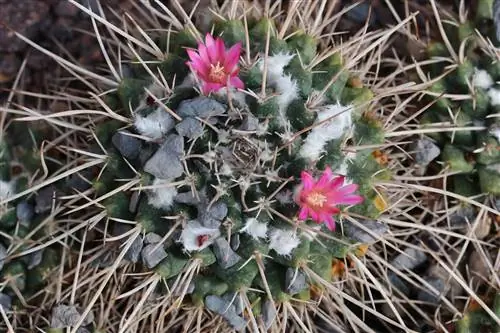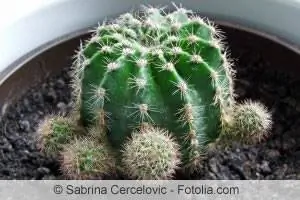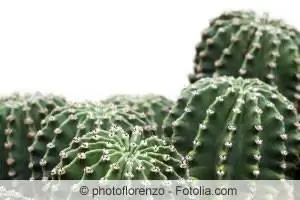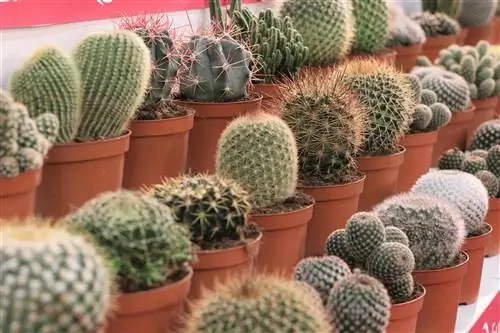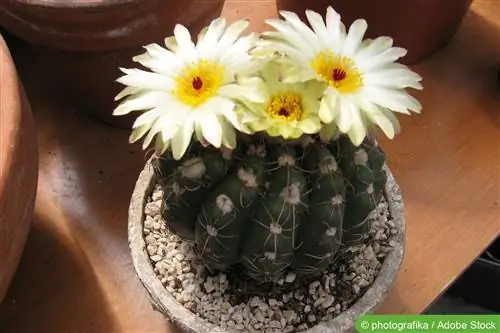- Author admin [email protected].
- Public 2023-12-17 03:39.
- Last modified 2025-01-24 12:45.
The large and small flowers of the Mammillaria species bloom in white, yellow and many shades of red and pink. They do well with lots of sun and little care. The thorns are sometimes numerous, sometimes rather sparse, sometimes soft and hairy or threateningly pointed, sometimes arranged in rings or stripes on their trunks. The cactus plants are succulents. Most species in the Mammillaria genus are native to Mexico and southern North America.
Location
The Mammillaria species feel most comfortable in the sun. In summer they like to be outside. Otherwise, they do very well in a sunny spot at normal room temperature. Winter is rest time. Here the temperatures should be significantly cooler, around 10 °C. But bright and sunny! A place in an unheated winter garden is optimal. The less sunlight the Mammillaria gets throughout the year, the less likely it is to bloom profusely. Tip: Apart from moving to winter quarters, the Mammillaria species don't like being moved around or constantly being crazy.
Floor
Normal potting soil or special soil? If you want to be on the safe side with the substrate, you can buy special cactus soil. There are many opinions among enthusiasts about choosing or mixing the right substrate. Basically, the soil should be well-drained, mineral-rich with a pH value of neutral to slightly acidic. If you want to try normal potting soil, you can mix a third of it with sand, expanded clay, perlite, pumice or lava grit. Seramis clay is also suitable for improving drainage properties. With some cactus cultures you only see gravel around the plant. This was applied superficially as decoration and otherwise brings no further advantage. This makes it difficult to see how far the substrate has dried out.
Tip:
Sharp sand is always recommended as a sand admixture. This is broken sand, not the rounded, fine beach sand. Sharp sand offers better drainage thanks to the break edges and releases more minerals into the substrate.
Watering, fertilizing
Yes, it's true, most cacti are watered or the roots are left in water for too long due to poor permeability. In the growth phase from spring to the beginning of autumn, the rule of thumb to remember is “water every 8 days”. This information only serves as a rough guide; during this period, check whether the substrate in the upper layer has already dried. Accordingly, watering has to be done after 7 days or after 10 days. However, watering should be done carefully.
If water remains at the bottom between the mother plant and the children, they can rot in these places. A good option is to place these cacti in a water bath until the soil on the surface feels slightly moist. The Mammillaria should never stand in water for longer. During the rest period in winter, you only water when the substrate is completely dry. To provide nutrients during the growth phase, add cactus fertilizer to the irrigation water once a month. This fertilizer is particularly low in nitrogen and contains a lot of potassium and phosphorus.
Repotting
Regular repotting is also part of caring for Mammillaria species. Creeping species or group arrangements look best in wide bowls. Upright growing species can be placed in normal flower pots. The best time to repot is shortly before the growth phase begins in spring. The size of the pot depends on the diameter of the Mammillaria species and its tendency to sprout wide. Roughly speaking, the diameter of the planter can be twice as large as that of the cactus at its base. It is repotted when the old container is well rooted. When repotting, make sure
- that the old substrate is carefully shaken out of the roots.
- that fresh substrate is used for the new pot.
- that, depending on the thorns, you have sufficient protective measures at hand (gloves, spaghetti or cucumber tongs, etc.).
- place the container on the ground several times after filling so that no air holes remain.
Propagate
It is easiest to propagate the group-forming species of Mammillaria. These species form many so-called kindles at their base. These are then cut off with a clean knife. The cut surface must first dry out for 2-3 days. Then the cut surface of the children is pressed into the substrate. Propagation by seeds or even seeds from your own Mammillaria, on the other hand, is a little more complex. If you would like to try this, you should find out more in the relevant specialist and enthusiast forums.
Diseases and pests
Mealybugs and spider mites are the most common. In the early stages, it can help to brush off the infestation or remove it individually with tweezers. Then brush the affected areas with a solution of water, 1/10 soft soap and 1/10 spirit. Applying oil (e.g. rapeseed oil) has also proven effective in killing mites and lice.
Tip:
Be sure to examine the cacti regularly. The sooner you discover the pests, the easier it is to get rid of them without causing major damage to the cactus. Be sure to place an infected cactus separately.
Species
As already mentioned, there are a particularly large number of different species in the Mammillaria cactus family. This awakens a passion for collecting in many people. Some particularly attractive species are presented below:
- Mammillaria boscana: A mostly small because it grows very slowly, green, round and covered in white thorns. The small flowers are funnel-shaped. There are different types that bloom white, yellow and pink.
- Mammillaria elongata: This green cactus produces many cylindrical shoots that are covered in yellow thorns. This cactus is very easy to care for and grows reasonably well. The flowers are mostly light yellow.
- Mammillaria luethyi: An impressive, beautiful Mammillaria species. The Luethyi grow spherical, dark green with snow-white, clumped thorns. The flowers are particularly large and, with their bright pink, can completely hide the stem itself.
- Mammillaria senilis: It actually looks senile due to its white, hairy growths between the thorns. The “senile” impression disappears with the flowering, because then it produces very tall, funnel-shaped, bright red flowers.
- Mammillaria spinosissima: Here too, the name already shows what sets it apart: spinosissima, very thorny. In fact, it has several layers of thorns. The longest ones are hard and red, the smaller ones are white and sometimes interspersed with hair. It produces many small, pink flowers.
- Mammillaria vetula: This type of cactus is rather broad and forms many small, spherical trunks. They are covered all over with white wool and white thorns. It grows as a flat cushion with its many sprouts. The flowers are small, white-yellow to old pink.
Conclusion of the editors
Many Mammillaria species are absolutely easy to care for. However, in order for them to bloom diligently, the right amounts of sunlight and water are crucial. The retirement location has proven to be particularly important for flowering: bright, sunny and cool. Anyone who has ever made a Mammillaria bloom will be on the lookout for other species - guaranteed!
What you should know about Mammillarias in brief
- Mammillarias are warty cacti. They number about 300 species. The flower wreaths are characteristic.
- The plants originally come from the south of the USA, Mexico, Guatemala, Honduras to Venezuela and northern Colombia.
- They have also been found occasionally on the Caribbean islands.
- Mammillarias are succulents with a spherical or elongated shape.
- They are known as individual specimens, but also as cushions. These are formed by side shoots.
- Instead of ribs, like many cacti, the plants have warts.
- These can have different shapes and be arranged in overlapping spirals (touch lines).
- The depressions between the warts (axillae) can be bald or have more or less long hair.
- Some species develop the axillary wool more strongly in the flowering region. Ring-shaped woolly zones then appear there.
- The cacti grow up to 30 cm high. The height of growth varies depending on the species.
- Mammillarias have quite different spines. The spines can be straight, curved or hooked.
- The flowers appear mainly from spring to summer, always wreath-shaped from the axillae of the previous year's growth.
- The flowers are hermaphrodite, tubular, bell-shaped or wheel-shaped and also vary in size.
- The colors of the petals range from white to yellowish to various shades of red.
- After the flowers bloom, fruits appear. Their color is greenish to reddish, sometimes bright red.
- The fruits are juicy and have a cylindrical to ovoid shape. They can be 5 to 30 mm long.
- The location for the Mammillaria should be bright, warm and sunny to partially shaded. They require little care.
- The planting substrate should be semi-heavy, slightly mineral, slightly sandy-gravelly with a small amount of clay added, humus, nutritious and slightly acidic.
- Mineral soil ensures a strong, humus-rich soil for a colorful spike.
- In summer the plants like to be kept warm, sunny to slightly shady.
- During the transition period, outdoor cacti must be protected from the blazing midday sun.
- They should also not be exposed to the rain. You should water sparingly. Waterlogging must be avoided at all costs.
- The mammillaria overwinter in a light, dry and cool place (8 to a maximum of 14 °C).
- The easiest plants to propagate are via sprouts, which are easily formed. Propagation is also possible via sowing.

